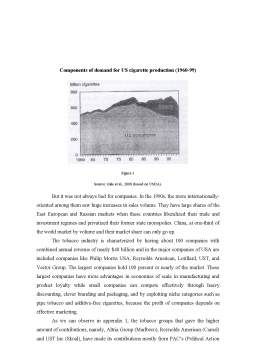Cuprins
- Introduction.pág.3
- Lobby Definition.pág.5
- Industry of Tobacco.pág.5
- Tobacco lobby.pág.8
- Tobacco politics.pág.9
- Public Choice.pág.9
- Rational Choice.pág.10
- Conclusions.pág.11
Extras din referat
Introduction
The history of commercial tobacco production in the United States dates back to the 17th century when the first commercial crop was planted. The industry originated was in charge for the production of tobacco for pipes and snuff. Different wars around the world created a shift in demand and production of tobacco. With the American Revolution, trade with the colonies was interrupted which shifted trade to other countries. During this shift there was an increase in demand for tobacco in the United States, where the demand for cigars and chewing tobacco increased.
During the 17th century, Europe had a growing demand for tobacco. However, the American south, where tobacco grew well, capital was needed in order to grow this highly demanding crop. These farmers saw tobacco as a temporary crop to get them started until they could plant something else. Their reason behind the temporary status given to tobacco had to do with low prices. “During this century, in Virginia tobacco was selling for pennies per pound. Solutions to this problem came with slavery. Slavery had already existed in the colonies, but a new influx would greatly expand tobacco production” (Gately, Iain 2001).
The need for slaves was a response to low birth rates of the European settlers in America. Slavery would help to keep costs down and profits higher. It would change tobacco farms, going from small to larger farms, which demanded large labour forces, which was provided by slaves. Slavery was an important part of the process of growing tobacco, especially in the American colonies.
By the end of the 18th century, a renewed interest in tobacco took hold. In turn, this meant more demand for tobacco from America again, and this meant a boom in increased slavery in the southern United States where tobacco was grown. After American Revolution, there was a huge increase of the tobacco price. Wartime had a big influence over the price of tobacco because, “just prior to the Revolution, there was a small peak in price during the Seven Years War when different cultures gained a desire for tobacco after fighting opponents who had been smoking it” (Kulikoff, Allan 1986).
Advents like The American Civil War and the Emancipation Proclamation free the entire slave workforce of the American South and, because of this, tobacco farmers needed to adapt. They had lost their workforce and they had also to face a shift in demand. In Europe, there was a desire for snuff, pipes and cigars, but cigarettes appeared as well. Cigar rolling and even the creation of pipe tobacco at the time were laboured intensive and, without slave labour, innovation was needed. Cigarette was the solution. The next step to limiting labour was the process of creating the cigarette with a new machine that was created in 1881.
Companies began advertising cheaper cigarettes from Europe to United States. Because of this easy way to produce cigarettes, many other forms of tobacco quickly were put on the market by the American tobacco industry and, as a result, sales of cigarettes grew exponentially (Burns, Eric. 2007). For example, “American Tobacco Co., listed on the American Stock Exchange, with sales of $25,000,000 in 1890, increased its sales to $316,000,000 in 1903” (Porter, Patrick P. 1969). Tobacco industry was very important for the American economy after the Civil War “debts were paid off; taxes were almost completely removed from cigarettes” (Porter, Patrick P. 1969). From this time, the cigarette became a part of the American culture that was interrupted when scientific revelations discovered the health consequences of smoking in the mid-20th century.
Tobacco is not only a business like the others; we will show you this industry is very organized in influent groups – lobbies – which pays a lot of money to politicians in order to manipulate international trade and lawmakers and, as a result, increase profits.
Lobby Definition
About rational choice, which will be discussed further, it’s important to discuss the behavior of rent seeking that is important in the formulation of trade policy, and lobbies are one example. The lobbies’ activities are regulated and legal and monetary contributions are possible in election campaigns. More important is the influence of lobbies on government decisions in the context of international trade, and in USA these groups have a great influence and are institutionalized. This type of behavior (rent-seeking) appears because firms want better income, profit and monopoly positions. (Guimarães, 2005).
Lobby can be “a group, organization or association seeking to influence the passage or defeat of legislation. Originally, the term referred to persons frequenting the lobbies or corridors of legislative chambers in order to speak to lawmakers.” (Lectlaw)
The practice of influencing government decisions it calls lobbying, and examples of that are legislators and officials constituents or organized groups.
Industry of Tobacco
As we wrote before, no other product has stimulated demand for tobacco as much as the cigarette. Until the 1870s, cigarettes were mainly rolled by hand. Today, the machines took account of that. Machines can produce hundreds if not thousands of sticks per minute, cigarettes have become an article of mass consumption. In the process, cigarettes have become the main tobacco product. Today, over 80 per cent of tobacco grown is used for cigarettes. The world market for cigarettes is dominated by a low and steadily diminishing number of suppliers.
Preview document
Conținut arhivă zip
- Tabacco Lobbies.doc



















